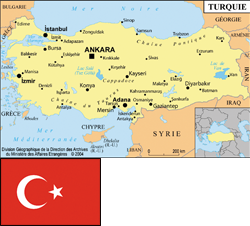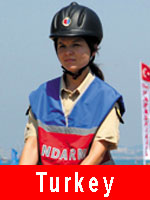
Turkish Gendarmerie
|
1839 Ministry of attachment: Ministère de l’Intérieur et État-Major Général des Armées Turques Workforce: 166 000 General manager: Général d’armée Yasar GÜLER Address: Jandarma Genel Komutanligi Tél.: +90 312 456 22 65 Website: www.jandarma.gov.tr/ Email: dia@jandarma.tsk.tr 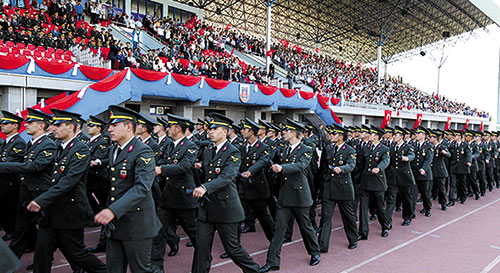
|
History
After the abolition of the Ottoman Empire "janissaires" body in 1826, the military organizations called Asakir-i-i Muntazâma Mansure, Asakir-i-i Muntazâma Hassa, and, in 1834, Asakir-i Redîfe are organized in order to insure the security and the maintenance of law and order in Anatolia and in certain provinces of Roumélie. The term of gendarmerie appears in the application decrees published in the years that follow the Tanzimat declaration in 1839. After the Second Russian-Turkish War (1877-1878), the Prime Minister Mehmed Saïd Pacha makes French and British officers come to modernize law enforcement. In 1879, the Turkish gendarmerie receives its current naming of Jandarma. In 1908, after the Young Turks revolution, the Corps pursues its modernization. In 1909, the gendarmerie is connected with the war ministry and takes the name of Gendarmerie General Command (Umum Jandarma Kumandanligi). During the World War I, Jandarma, which continues to insure the internal security, is committed on all the fronts. The law n° 1706 of June 10th, 1930 fixes the current legal status of the Jandarma, its organization and asserts its military character. In 1956, the law n° 6815 spreads its sphere of action to the protection of the borders, the coast and the territorial waters and to the fight against the smuggling and contraband. In 1968, the first Air Gendarmerie unit is created to Diyarbakir. In 1974, some elements of this flight unit and the Mobile Gendarmerie anti-riot unit participate in the invasion of Cyprus. The law n° 2803 of March 10th, 1983 specifies the organization of the Turkish Gendarmerie, its missions and its skills (JO 17985 of 12/03/83, law n° 2803). From 1984, the Jandarma units are involved and committed in the fight against the PKK/KCK terrorist organisation. In 1993, criminal investigation gendarmerie department is created in Ankara. Several Crime laboratories are settled in Van, in 1994, in Bursa, in 1998, and in Aydin, in 2005. In 1998, Jandarma adheres to the FIEP. In 2001, this institution counts 275 000 staffs. At the present time, besides its traditional missions, Jandarma participates in the fight against terrorism and in the control of its borders.
(3).jpg)
Organization
The Turkish Gendarmerie depends on:
• the Turkish General Army Forces Staff for formation, the training and some specific missions defined by the military laws and regulations;
• the Ministry of the Interior regarding security and law and order;
• the Ministry of Justice for the Criminal Investigation Department missions.
Central Organization
The general command is located in Ankara, capital of Turkey. It includes a general headquarters and commands (of the formation, logistic, interior security troops, air forces units and other forces ...). This organ is in charge of assisting the General Commander in the decision-making within the framework of the command, of the control, of the institution development and the follow-up of the execution of its projects. It exercises its authority on all the Gendarmerie regional units that have the responsibility, in their respective districts, the maintenance of law and order and the public security. It has to this end a complete network of communication and computerized processing by the data.
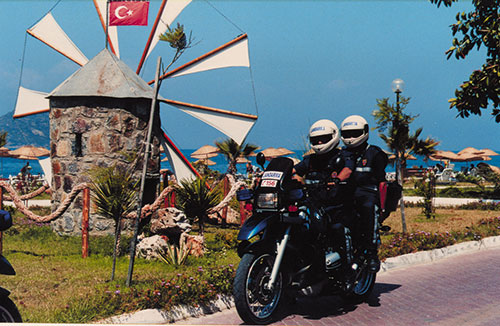
Territorial organization
The Jandarma covers 91% of the territory for 22% of the population. The distribution of the competence between police and Jandarma is based on the only territorial criteria. The departmental squads of Gendarmes are under the authority of the governors, and the companies under that of the district governors (the governors represent Home Secretary).
• 14 regions of gendarmerie. Every region, under a general of brigade or division’s command, includes 4 to 10 squads of Gendarmes. The region commander has at his disposal a battalion of gendarmerie commando composed of three companies (civil security, special interventions, intelligence);
• 81 departmental squads of Gendarmes (provinces), under a colonel’s command. Every squad of Gendarmes includes from 2 to 26 companies, and a commando squadron. According to its importance, the squad of Gendarmes can have a unit in charge of sensitive spots or a jail surveillance unit. It can also include a Criminal Investigation, mine clearance and maintenance of law and order unit;
• 931 companies of departmental gendarmerie, under a captain, a lieutenant or by an upper officer’s command. They have at their disposal several road traffic surveillance teams;
• 1 997 territorial brigades, under the command of a non-commissioned officer and composed of conscripts. They are in charge of the preservation of beauty spots and the security of villages.
Specialized Training
(9).jpg)
• The anti-riot police (Mobile Gendarmerie) consists of mobile reserve units and commando squads trained for any antiterrorist operations:
- the gendarmerie commando units consist of 40 battalions commando, 107 companies commando of law and order and 24 special operations battalions, specialized in the counter-terrorism.
• Jandarma light aviation units: 3 air groups (Ankara, Diyarbakir and Aydin) as well as a squadron in Van, with approximately 65 aircrafts. The missions of this strength are the logistic support, the rescue operations, the missions of maintenance of law and order and public security.
• Coastal and river intervention platoons, which can support the action of the coastguards in the surveillance and the fight against the traffics.
• Sections of prevention for the domestic violence and violence against women.
• Environmental protection teams.
• Road traffic teams.
• Mountain Research teams.
• Scenes of crime investigation teams.
• Dog teams.
• Scuba divers teams.
Missions
The law n° 2803 of March 10th, 1983 on the organization, the missions and the competences of the Gendarmerie set up four domains of responsibilities: administrative, judicial, military and others.
The administrative functions cover all the prevention measures in order to insure the law and order and the security of the citizens and their properties, by enforcing the law.
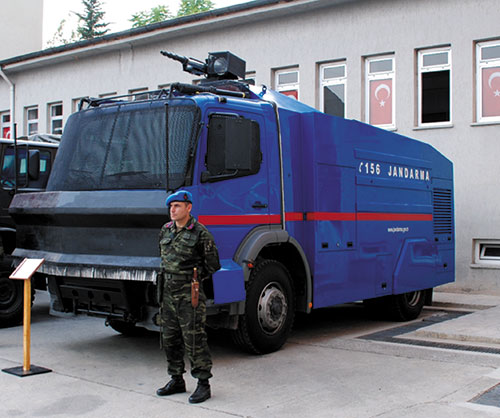
The judicial functions cover all the acts relative to the observation/finding of breaches, in gathering evidences, in the search of the authors and their presentation before the courts.
The military missions are all the tasks promulgated by military laws and regulations and ordered by the Turkish Military Command.
All other attributions are fixed by decree and executed according to the law.
Staff
The staff of the gendarmerie is shared out in officers, non-commissioned officers, specialized gendarmes, junior, conscripts, state employees and civil workers. Since the beginning of the XIXth century, Jandarma is fronting a sensitive reduction of its staff passing from 275 000 staffs to 235 000, in 2011 and 166 000, in 2016. This reduction is bound to the more important recruitment of the National police force and to the reduction of the military service, which passed from 15 to 12 months on January 1st, 2014. This last measure had an impact on the number of "callees" for the national military service, which are at present 75 000 (45% of the staff of the body). The Turkish gendarmes live in barracks. Three modes of recruitment and thus trainings coexist. The staffs recruited at the university level (High school diploma + 4 academic years) are doing a one-year initial training course. The gendarmes recruited on a high school diploma are doing a two-year training course just like those recruited by internal competition.
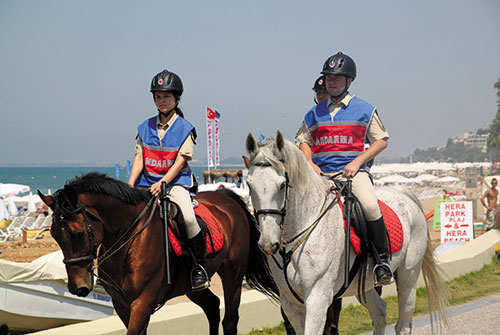
Training institutions
A single training school of Jandarma, located in Ankara, includes an officers’ training school for the officers and a non-commissioned officers’ school. 300 officers are trained there each year, coming from the Army (land forces), military academy (11 months training) or from the university community (2 years training). The non-commissioned officers follow as for them a two-years training, for the gendarmes recruited on a diploma of high school base just like those recruited by internal competition and who are coming from Army (land forces) initial training school. Besides, there is a commando school of training in Izmir.
Main equipment
• Armament: pistols P90, Kalachnikov, machine guns LMG-K, light machine guns HK23E, multi-purpose machine guns PKM, grenade launcher HK 69.
• Vehicles: cars 4x4 S550 Shorland, BTR-80PB, armoured light 4x4 Otokar Akrep, armoured 4x4 Otokar Cobra, armoured in wheels 4x4 Dragon 300, Condor, UR416, Cadillac V150.
• Aerials means: Helicopters: Sikorsky UH 60 Blackhawk, S-70A28 Blackhawk, S-70A17 Blackhawk, AB215A1, Mi-17IVA.
Cooperation
Finally, the Turkish Jandarma is very involved in the international network. Since 1998, it is a member of the FIEP (France - Italy - Spain - Portugal), police forces association with military European and Mediterranean status and member of the ENFSI (European Network of Forensic Science Institute). Since 2010, it is an observer country of the FGE (European gendarmerie Force). Since 2013, it is a member of the TAKM (Turkey- Azerbaijan -Kirghizstan-Mongolia), Eurasian Gendarmerie Force.
(6).jpg)
© The iconography was provided by the concerned gendarmeries

